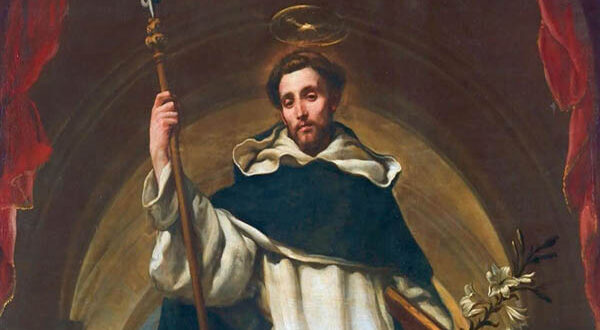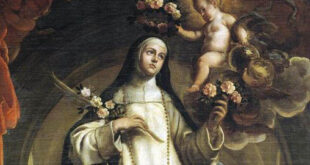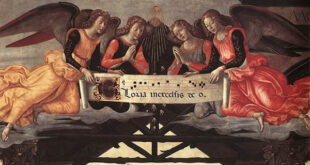“Woe to me if I do not preach the Gospel” (1 Cor 9:16)
Introduction: Why Saint Dominic Today?
In a world overwhelmed by noise, relativism, and a loss of the transcendent, the figure of Saint Dominic de Guzmán shines brightly as an example of clarity, apostolic zeal, and unconditional love for the Truth revealed by God. In an age of doctrinal confusion and the threat of heresies—just like today—Dominic was raised up by the Holy Spirit to preach with fire, to found with wisdom, and to pray with effectiveness. Now more than ever, we need to turn our eyes to this great saint: to learn from his life, to be challenged by his example, and to apply his legacy to our own times.
I. Biography of Saint Dominic de Guzmán
1.1. Birth and Family
Dominic de Guzmán was born in Caleruega, in today’s province of Burgos, in the year 1170. He was the son of Félix de Guzmán and Juana de Aza, a noble and deeply Christian family. From the moment of his conception, his mother had a prophetic dream: she saw herself carrying a dog with a torch in its mouth that set the whole world on fire. This was later understood as a sign that Dominic would be a light-bearing preacher in a world covered in darkness.
1.2. Youth and Formation
He studied in Palencia, one of the most prominent universities in Castile at the time. There, he was trained in liberal arts and theology. He was known not only for his intelligence but especially for his austerity and charity: he sold his books—which were extremely expensive in those days—to help the poor during a famine. This generous disposition would blossom into a total commitment to the service of preaching.
1.3. The Birth of a Preacher
Ordained a priest and a member of the cathedral chapter of Osma, he accompanied Bishop Diego on a diplomatic mission through Europe. But it was in southern France that Dominic discovered his true field of mission: the Cathar heresy, a dangerous Gnostic doctrine that denied the sacraments, the Incarnation of Christ, and promoted a radical dualism. Many Catholics were being misled by the apparent piety of the Cathars, and the Church was suffering a severe crisis of credibility.
Dominic realized that the answer was not force, but the truth preached with humility, a life of austerity, and persevering prayer.
II. The Foundation of the Order of Preachers
In the year 1216, Dominic received papal approval to found the Order of Preachers (O.P.), today known as the Dominicans. Their motto: “Veritas” (Truth).
Unlike other monastic orders, the Dominicans were not founded for isolation but for mission. They were well-formed clerics, zealous for doctrine, and driven by a deep desire to save souls. They traveled on foot, lived in community, studied rigorously, and preached passionately.
The Dominican charism can be summarized as:
- Contemplata aliis tradere: “To hand on to others what is contemplated.”
- Prayer, study, community, and preaching as the pillars of life.
- A burning devotion to the Blessed Virgin Mary, especially through the Holy Rosary.
III. Saint Dominic and the Rosary
One of the Church’s most beautiful traditions holds that the Blessed Virgin Mary gave the Rosary to Saint Dominic as a spiritual weapon against heresy.
The Rosary is not merely a popular devotion. It is a true compendium of the Gospel, a simple and profound way of contemplating the life of Christ through the eyes and heart of Mary. Saint Dominic understood that to convert heretics, it was not enough to argue intellectually—one had to attack the spiritual root of error with prayer and meditation on the mysteries of Redemption.
This powerful spiritual tool spread thanks to his preaching, and ever since, the Rosary has saved souls, crushed errors, and protected the Church in its darkest moments.
IV. Spiritual and Theological Teachings of Saint Dominic
4.1. Zeal for the Truth
Dominic lived with absolute radicalism the call of Saint Paul: “Proclaim the word; be persistent whether it is convenient or inconvenient; convince, reprimand, encourage through all patience and teaching” (2 Tim 4:2). In times when truth is relativized or diluted, Saint Dominic reminds us that Christ is the Truth (cf. Jn 14:6), and that charity without truth is sentimentality, and truth without charity is harshness.
4.2. Poverty and Prayer as Means of Evangelization
He preached barefoot, slept on the ground, fasted constantly, and spent entire nights in prayer. He was not an activist, but a contemplative in action. He knew that conversion is not achieved through words alone, but through witness of life and sacrifice. In fact, it is said that he never spoke to someone before speaking to God about them.
4.3. Love for the Church and Obedience to the Pope
Dominic had a profound ecclesial sense. He never acted on his own and consulted the Holy See on all his missions and decisions. At a time of internal tensions and abuses, Saint Dominic was a model of communion, fidelity, and reform from within.
V. Curiosities and Anecdotes
- He was never a bishop, though he was offered several prominent dioceses. He rejected all honors to dedicate himself to preaching.
- He left behind only nine ways of praying, which were deeply symbolic bodily gestures: from genuflection to full prostration.
- He died on August 6, 1221, in Bologna, surrounded by his brothers, asking them to love one another and live in humility.
- He was canonized quickly: in 1234, by Pope Gregory IX, who knew him personally and considered him a “true athlete of Christ.”
VI. Practical Applications for Today
6.1. For the Laity
- Solid doctrinal formation: like Dominic, we need to know the faith in order to defend and transmit it.
- Daily prayer of the Rosary: to use it as a shield against confusion, sin, and temptation.
- Living in austerity and joy: renouncing consumerism and cultivating evangelical simplicity.
- Being a light in the midst of the world, preaching by example and with words filled with truth and charity.
6.2. For Priests and Religious
- Return to apostolic zeal: not settling for the minimum, but burning with love for souls.
- Recover doctrinal preaching: in a world of confusion, people need clear doctrine, not spiritual entertainment.
- Live community life as a school of holiness.
- Combine deep study and contemplative prayer as the foundation of all mission.
VII. Dominican Pastoral and Theological Guide
| Element | Pastoral Application | Theological Foundation |
|---|---|---|
| Preaching | Clear homilies, systematic catechesis, online presence. | Christ preached: “He has sent me to proclaim the good news” (Lk 4:18). |
| Rosary | Promotion of the Rosary in families, parishes, schools. | The Rosary as Mary’s “psalter,” a contemplation of the Incarnation and Redemption. |
| Study | Ongoing formation of pastoral agents. | Faith seeks understanding (fides quaerens intellectum) – St. Anselm. |
| Poverty | Simple, austere, prophetic life. | Christ became poor for our sake (cf. 2 Cor 8:9). |
| Fraternal life | Vibrant communities, accompaniment, fraternal correction. | “See how they love one another” (cf. Jn 13:35). |
| Night prayer | Holy hours, vigils, intercession for the world. | Jesus spent the night in prayer (cf. Lk 6:12). |
VIII. Conclusion: Saint Dominic and Us
Saint Dominic de Guzmán was not a man of the past, but a prophet for our time. In a Church that needs purification, clarity, and apostolic zeal, his figure reminds us that Truth does not need embellishments, but witnesses. That heresy is not fought with hatred, but with prayer, study, and burning charity. That the Rosary is not an old tradition, but an invincible weapon.
Recovering the Dominican spirit is not a luxury—it is a necessity. And like him, let us repeat with inflamed hearts: “Lord, what will become of sinners?”
Saint Dominic de Guzmán, preacher of Truth, pray for us.
Make us witnesses of the faith, defenders of doctrine, apostles of the Rosary, and friends of Christ.






